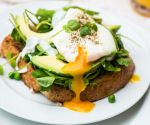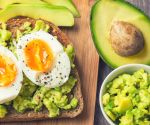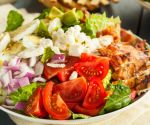Advertisement
In very simple terms, a high-fat diet cannot satisfy your appetite as well as a high-protein diet when the calories are equal in both. This would lead you to eat more calories on a high-fat diet in order to feel full. One gram of fat holds ~ 9 calories compared to 1gm of protein yielding only ~4 and because of this and respective water content, the volume of food in equal caloric diets is far greater in the high-protein diet, also adding to fullness. Additionally, it takes very little energy (calories) to metabolize fat compared to protein. Dietary fat can be stored very easily as body fat when energy needs are met with other foods. But protein must go through a much longer process to be used or stored as energy, meaning you use over twice the calories when you metabolize dietary protein. For these and other reasons, protein has been proven in studies to be the most satiating of the three macronutrients (protein, carbohydrates and fats), meaning protein makes you feel full sooner. Also high-protein diets are simple because they limit most other foods and people get tired of eating protein all day, leading to an automatic reduction in calories. Not all high-protein diets are healthy, but as long as you keep the total protein less than 35% of your daily calories and include lots of fruits and vegetables (and whole grains where possible), short-term use can be a safe and effective weight loss solution.
The main reason a high protein diet helps people lose weight is because people wind up eating fewer calories than they did before they started the diet. Most high protein diets require that you drastically limit carbohydrates, and if you eliminate bread, pasta, cookies, cake and the like, it's no surprise that you'll lower calorie levels and lose weight. Protein is also satiating, meaning it helps you feel full and quells appetite, always a plus for weight loss.
On the other hand, you're not cutting out any food groups on a high fat diet, so you don't get the automatiic calorie drop. And because fat has more than double the calories per gram as protein (or carbohydrates) it's easy to rack up calories on a high fat diet.
That said, I don't recommend either type of diet. My gripe against high protein diets (like Atkins) is that you not only restrict unhealthy carbs like cookies, but you cut out whole grains, certain fruit and other healthy carbs. Instead, I recommend that you limit these foods, but not cut them out. If you're trying to lose weight, have about 5 servings of whole grains or starchy vegetables, like potatoes. A serving is 80 calories, and is about a half cup of cooked pasta, sweet potatoes, or 1/3 cup rice or legumes. As for cereal, check labels to see the cup measure of 80 calories.
As for the amount of fat in your diet, 30 to 35 percent works well for most people--that's moderate, not high. Most of your fats should be "good" fats--rich in mono- and poly-unsaturated oils, foods like olive oil, canola oil, flaxseeds and other seeds, nuts and avocados. Also make sure to eat fatty fish like salmon and sardines 3 times a week for omega-3s (a type of poly). If you're trying to lose weight, aim for about 5 to 6 fat servings daily; a serving is 45 calories, such a teaspoon of oil or a tablespoon of nuts.
Meanwhile, have about 6 to 8 protein servings daily--a serving is about 50 to 65 calories such as an ounce of seafood, poultry or meat (limit red meat to no more than once weekly); one egg; 2 - 4 ounces tofu.
Round out your diet with 2 servings (90 - 100 calories) of nonfat milk or calcium-fortified soymilk, nonfat or lowfat yogurt, and have plenty of vegetables and at least 2 fruits daily.
On the other hand, you're not cutting out any food groups on a high fat diet, so you don't get the automatiic calorie drop. And because fat has more than double the calories per gram as protein (or carbohydrates) it's easy to rack up calories on a high fat diet.
That said, I don't recommend either type of diet. My gripe against high protein diets (like Atkins) is that you not only restrict unhealthy carbs like cookies, but you cut out whole grains, certain fruit and other healthy carbs. Instead, I recommend that you limit these foods, but not cut them out. If you're trying to lose weight, have about 5 servings of whole grains or starchy vegetables, like potatoes. A serving is 80 calories, and is about a half cup of cooked pasta, sweet potatoes, or 1/3 cup rice or legumes. As for cereal, check labels to see the cup measure of 80 calories.
As for the amount of fat in your diet, 30 to 35 percent works well for most people--that's moderate, not high. Most of your fats should be "good" fats--rich in mono- and poly-unsaturated oils, foods like olive oil, canola oil, flaxseeds and other seeds, nuts and avocados. Also make sure to eat fatty fish like salmon and sardines 3 times a week for omega-3s (a type of poly). If you're trying to lose weight, aim for about 5 to 6 fat servings daily; a serving is 45 calories, such a teaspoon of oil or a tablespoon of nuts.
Meanwhile, have about 6 to 8 protein servings daily--a serving is about 50 to 65 calories such as an ounce of seafood, poultry or meat (limit red meat to no more than once weekly); one egg; 2 - 4 ounces tofu.
Round out your diet with 2 servings (90 - 100 calories) of nonfat milk or calcium-fortified soymilk, nonfat or lowfat yogurt, and have plenty of vegetables and at least 2 fruits daily.
Continue Learning about Nutrition and Weight Loss
Important: This content reflects information from various individuals and organizations and may offer alternative or opposing points of view. It should not be used for medical advice, diagnosis or treatment. As always, you should consult with your healthcare provider about your specific health needs.









